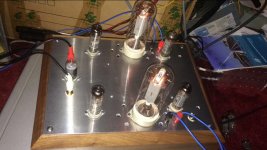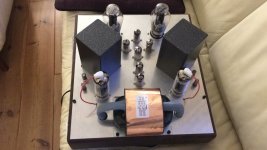Gramex was good. Much better than Harold "We-charge-you-Moore". There was also a good shop opposite Charing Cross station on the Strand. I used to hang out there and go for a coffee with musician friends.
Had a list in 1995 with all the good record stores in London- unfortunately, that bewared me from seeing the cultural stuff and the other parts of the country.
Always travelled saturdays Birmingham-London or hunted the newspapers for records. At the end, I had to ask a student to bring all those records to germany back, and he did. Some I did send by parcel post. Had a huge stock at the end, mostly the big names classical records. It was real cheap, compared to today.
Think it was the Charing Cross station shop that I took the most of it. Was always nice to talk and to meet people there. They were so relaxed.
Sorin Cristea,
devices in a balanced configuration constitute each other’s load impedance, that is, two large oppositely directed forces giving high distortion and high instability.
devices in a balanced configuration constitute each other’s load impedance, that is, two large oppositely directed forces giving high distortion and high instability.
Schmitz77,
a primitive formal language, such as the language of mathematics, allows for primitive reasoning and primitive models. Natural language predicates can be far more elaborate, however, expressibility has explicit limits. Quality is not demonstrable, but I am always interested in your personal impressions.
a primitive formal language, such as the language of mathematics, allows for primitive reasoning and primitive models. Natural language predicates can be far more elaborate, however, expressibility has explicit limits. Quality is not demonstrable, but I am always interested in your personal impressions.
Schmitz77,In general, with PP power amps its more easy to achieve high power output.
But we have seen, that doesn't mean high energy output.A PP amp could be of high power,
but low energy output, the design isn't able to put out powerfull octaves of voices, instruments etc.
very good observation, for once you are on the right track. Energy and force are inversely related. Among other deficiencies, the PP amp is a forceless performer, it has a poor dynamic range.
Last edited:
Mathematics is a primitive system supporting primitive concepts, defined by primitive conventions, has a primitive language composed of primitive symbols and syntax rules and its operational limit is demarcated by primitive logic. The language of science is constructed from such miserably poor elements. Mathematics is the epitome of simplicity, generality, commonality, metaphysical determinism, idealism and absolutism. What is advanced is the mathematical topic.
Do not compare class A SE amps with PA PP amps. Naturally there will be a difference. Do you also use class B or C SE amps ? I guess not as these would sound even worse !
Through my 10 years of auditioning many SE and PP amplifiers (BOTH pure class A), I've always founds strengths and weaknesses in both. I like listening to every kind of music, from "a girl with a guitar" to "three overdriven guitars playing simultaneously with double kick drum". And these are my conclusions:
-I hate THD and resulting IMD, even if it's 2nd harmonic
-PP always sounds cleaner and controlled, handles complex music well, but lacks micro-resolution
-SE gives that micro resolution and overtone coherency. This is especially apparent on string instruments and vocals, where you need harmonic integrity. But SE tends to "give away" easily even at half power.
-Both can give excellent bass and highs.
-So far my current favourite topology is pentode SE with deep CFB and UL. It gives me SE intimacy of details with PP control with complex music.
-A great PP I've auditioned is the Thrax Enyo - A GU50 pentode, again using CFB + UL. It gave me the SE intimacy.
In a few words, SE gives excellent tonality and coherency, but its distortion is always a drawback. No, I don't believe distortion to be a benefit, at least for my ears.
This is true. Anyone who says the contrary, try plotting inductance of a DC magnetized SE transformer starting within micro AC flux densities.
-I hate THD and resulting IMD, even if it's 2nd harmonic
-PP always sounds cleaner and controlled, handles complex music well, but lacks micro-resolution
-SE gives that micro resolution and overtone coherency. This is especially apparent on string instruments and vocals, where you need harmonic integrity. But SE tends to "give away" easily even at half power.
-Both can give excellent bass and highs.
-So far my current favourite topology is pentode SE with deep CFB and UL. It gives me SE intimacy of details with PP control with complex music.
-A great PP I've auditioned is the Thrax Enyo - A GU50 pentode, again using CFB + UL. It gave me the SE intimacy.
In a few words, SE gives excellent tonality and coherency, but its distortion is always a drawback. No, I don't believe distortion to be a benefit, at least for my ears.
That SE transformer has no hysteresis distortion is a myth. Both have this type of distortion in equal measure. Hysteresis distortion can only be reduced by using core material with less hysteresis, in both PP and SE transformers.
This is true. Anyone who says the contrary, try plotting inductance of a DC magnetized SE transformer starting within micro AC flux densities.
Last edited:
And these are my conclusions:
-I hate THD and resulting IMD, even if it's 2nd harmonic
-PP always sounds cleaner and controlled, handles complex music well, but lacks micro-resolution
-SE gives that micro resolution and overtone coherency. This is especially apparent on string instruments and vocals, where you need harmonic integrity. But SE tends to "give away" easily even at half power.
-Both can give excellent bass and highs.
I'd agree with all that!
In a few words, SE gives excellent tonality and coherency, but its distortion is always a drawback.
Your loudspeakers have difficulty handling complex signals.
I've owned a commercial SE amp (Audio note Quest) which I used with Tannoy Chatsworth. I was not satisfied with it for complex orchestral music. I have not used a conventional AB1 PP amp. I have designed and built several power differential amps which I have found to be very satisfactory. I do understand the points that Rod Coleman and others make and since I have a stash of 4P1L I will attempt a SE at some stage. I am also interested to try TubeLab's (and SmokingAmp's) new ideas with anode to grid feedback and source follower drive at the cathode in SE configuration.
Straight pentode with low screen voltages and global feedback here. Maintains a favourable and controlled harmonic profile coupled with reasonable output drive. Handles rock fine.So far my current favourite topology is pentode SE with deep CFB and UL. It gives me SE intimacy of details with PP control with complex music.
I do have good experiences with SE and PP amps. In case it can not handle complex signals there is a problem (probably) with your driver of the power tube(s).
Loudspeakers have difficulty handling complex signals and distort much more than amplifiers.
- Home
- Amplifiers
- Tubes / Valves
- Why has single ended output become popular
 Ray Brown gives you a lesson about amplifiers.
Ray Brown gives you a lesson about amplifiers. 

